This week’s Monday Roundup is sponsored by no one. Please contact our sales manager if you’d like to promote your organization or event in this space.
Welcome to Monday.
Here are the most noteworthy links and tidbits that came across our desks last week…
LA’s next “Great Street”: What was standing in the way of the City of Los Angeles’ exciting vision for updating Venice Blvd from car-centric thoroughfare to a modern, world-class street? It used to be owned by their state DOT. Now in City control, the project can begin. (Sound familiar?)
Thanks, Trump: The United States House Transportation & Infrastructure Committee’s new director of outreach and coalitions is the former director of federal relations for the American Petroleum Institute.
Now what? The numbers are in. And just as we suspected, road deaths have taken a striking spike in the U.S. Now the question is: What are we going to do about it?
Blame millenials: Most of the media coverage and official agency response to the increase in deaths has placed the blame on human behaviors — especially humans between 19-24 years old, 88 percent of whom say they have gone over the speed limit, texted, or ran a red light in the last month.
Safety through less driving: Road agencies love to frame big road projects as “safety projects” — but to make roads safer we need to invest more in transit so people can drive less.
Not Top 10: Oh look, a list of the “10 Best” bike lanes in America (from a very credible source) and Portland isn’t on the list.
Kroger lawsuit: The parent company of Fred Meyer faces a lawsuit because Portland resident Michael Trimble says they unfairly terminated him after he made requests to push his bicycle across a courtyard and carry it up stairs to his office. Trimble has no arms and uses an adaptive bike to get to work.
Advertisement
Tech and gridlock: A team of students from Cornell Tech found that better data about parking availability could help prevent gridlock in downtown Manhattan.
911 bikes: It’s no surprise that the most nimble and efficient vehicle to get through daily gridlock in cities is also the preferred vehicle of first responders at crowded events.
Ride pain-free: Portland Physical Therapist Kevin Schmidt (Pedal PT) was the featured expert in this Bicycling Magazine article on riding in comfort.
Even Mr. Money Mustache gets it: This is an excellent treatise on America’s wrong-headed approach to transportation from an unlikely source: a popular personal finance blog.
Against the wind: San Francisco bike advocates are facing an interesting new challenge: How tall buildings in the downtown core impact wind patterns (which can make cycling very difficult).
Soccer and road safety: The Portland Timbers will help carry the torch of Vision Zero for the City of Portland by in-match PSAs and other education and outreach efforts.
Outdoor industry politics: Massive outdoor industry trade show Outdoor Retailer has pulled out of Utah after 20 years because of that state’s stance on privatizing federal lands. Interbike has also said it won’t consider Utah as a new home.
Not just for kids: A company has designed a helmet in the style of Lego hair. You know you want one.
Bike-friendly, Euro-style: The certification program for being a “Cycle Friendly Employer” in the EU is subsidized by the government. It also makes excellent bike parking one of the top two essentials to even start the process.
Thanks to all the readers who sent in suggestions!
— Jonathan Maus: (503) 706-8804, @jonathan_maus on Twitter and jonathan@bikeportland.org
BikePortland is supported by the community (that means you!). Please become a subscriber or make a donation today.

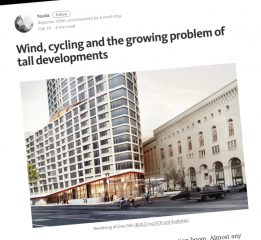
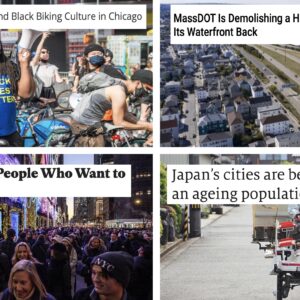
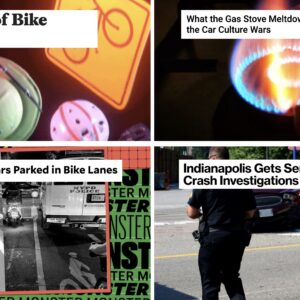
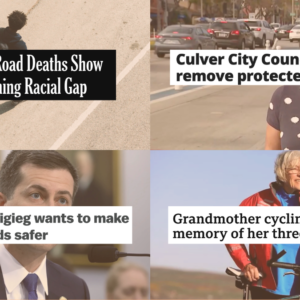
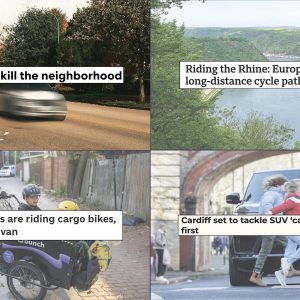
Thanks for reading.
BikePortland has served this community with independent community journalism since 2005. We rely on subscriptions from readers like you to survive. Your financial support is vital in keeping this valuable resource alive and well.
Please subscribe today to strengthen and expand our work.
The 911 bikes piece is poignant and puts into perspective one of the perennial topics we discuss here: speed humps and emergency vehicles and the problematic rules that govern these.
I sat at a red light yesterday and observed a confused Washington driver (who was trying to turn right from the middle lane on a red light just sit there like a confused moron while an ambulance came up behind them, came to a complete stop, and had to swerve around them, nearly up onto the sidewalk to get around. The biggest barrier to emergency response are drivers. If we really care about emergency response times, we would have a congestion charge to enter the city limits on any road, similar to London or Stockholm.
Streetblog piece on statistical safety by mode is great, but the emphasis on transit omits one crucial dimension which is that transit is *not* a substitute for most car trips we actually take; transit is not/cannot/never will be point-to-point. Bikes and walking *are* substitutes for car trips because they offer (sometimes even better) point-to-point service.
I believe that transit can and will be point to point in the future. Think self-driving vans with an algorithm that dynamically create routes based on where people want to go. They pick you up wherever you are, and pick up other people who happen to be going on a similar route along the way. There was a study recently showing that something similar could work: https://arstechnica.com/science/2017/01/algorithm-does-real-time-city-wide-ridesharing/
I knew someone would say this. I guess if you think of taxis as transit then I’ll concede the point. I don’t think of taxis as transit. If I give you a ride, or we carpool, or share a zipcar those aren’t transit. Taxis and vanpools to me are a grey area.
What if it’s a point-to-point dynamically routed bus? Would that be transit?
does that exist? how does it work? what is the cost per trip?
West Salem, where I currently live has a totally weird shuttle system which probably ranks right up there with the most gallons of fuel per passenger mile in the history of fossil fuels. It makes loops throughout the day essentially circling typical subdivisions without any through streets, and anyone can hail it via phone and be added to the route. It ‘works’ and may be along the lines of what you are thinking about, but from a fuel perspective I think just about anything would be preferable including a regular old taxi.
It may exist somewhere (not sure where, google didn’t help), but even if it doesn’t, it most certainly will. I’m just probing at what constitutes “transit”.
Regarding fuel consumption, on demand electric taxis might end up being more efficient than what we have now. Trimet (and transit systems in general) are not exactly efficient when it comes to CO2 emitted per passenger.
Actually, I’ve heard of “variable-route” public transit in rural areas of Minnesota, whereby a user calls the local public transit agency to pick them up at one of among a set choice of rural transit stops, while on-board passengers ask the drivers to drop them off at one of the same set of transit stops. The bus has a different route each day, depending upon calls. In Minnesota, and I think in many other states, “variable-route” transit is only available in rural areas and small towns, while urban areas over a certain population are required to have “fixed-route” transit, like Trimet’s.
Lots of crazy schemes exist, are put in place. The West Salem Connector is great if you want a ride (for $1.60), but the system strikes me as a disaster if we take a larger view, if we’re concerned with either fiscal or fuel prudence.
This is not the most credible presentation, but I verified at least some of the numbers with other sources, and data sources are listed. If the numbers are correct, then so is their conclusion: if you are concerned solely with energy, we should scrap Trimet and replace it with a fleet of small, efficient cars.
http://www.debunkingportland.com/transit/busvscartedb.htm
If Trimet is going to move forward with their ill-conceived BRT on Division, I really hope they go for the electric buses.
that looks an awful lot like something Randy O’Toole might have put together.
Sadly, it does.
But he’s not wrong on every single issue; he’s not that good!
A similar analysis from someone who makes the case for using transit despite the energy issue. I don’t know Templeton’s politics, but I do know him from the internet back in the 1980s. That’s right, kids, the internet did exist before Twitbook and Facegram, and even before this newfangled web thing was invented. And even back then there were libertarians (and dog people) bitching about NIMBYs in San Francisco. I guess some things never change. Or I never learn.
http://www.templetons.com/brad/transit-myth.html
I believe such a system, well implemented, using vans of 6 – 14 or so people, could very effectively replace both private automobiles and buses. The algorithms would make sure that the vans are mostly full, saving fuel, and also that routes are fairly direct, saving time. The lack of drivers makes it work economically.
This does not exist currently. The technology is not quite there, but it’s getting very close. When this happens, I think we can eliminate nearly all private cars and all city busses. Bikes and walking will still be a good option too of course.
A friend is bike touring southeast asia. He wrote “After spending some time in countries with no minimum driving age, it’s clear that kids should be able to drive when they can reach everything. But you gotta take the licences away from boys between 15-25”.
Exactly. Blaming young drivers for the uptick in deaths is ridiculous. Young drivers have always been a problem, and distracted driving is just a small part of the increase. The main reason is the general uptick in VMT due to a booming economy and low gas prices.
NIMBY in urban SF are against tall buildings and density.
It’s really that simple?
Yes. Someone in another city doesn’t want a tall building next to their house, so rick has declared they have nothing valuable to contribute, and dismisses them with an insult. What could someone who looks at an issue differently possibly have to offer?
It’s more complex than that, but he is generally right. SF is a case study in terrible urban planning. The NIMBY’s run the show, which is why they have the most expensive housing in the country. The “wind concerns” are just another arrow in their quiver. It will be interesting to see what they come up with next.
Why would anyone want to live in a place full of lowlife degenerate NIMBYs? Don’t those animals know what’s good for them?!? I hear Detroit is open for business!
I getcha. I had a NIMBY on my foot once. Went to three different doctors. Each one felt bad for me but just didn’t want to treat me themselves. Now there’s NIMBYs all over my house and I have to wear mittens when I take a shower.
Try not to scratch.
The problem is that just about every aspect of a project is subject to discretionary review in San Francisco. This isn’t the case in Portland, where our development code is for the most part clear, objective, and–crucially–fleshed out before a project goes in for review.
In the specific case of One Oak I have no idea if the people turning up at Planning Commission meetings really are bike advocates who have a specific concern about one aspect of the building’s design. But it seems at least feasible that some of them are people who are interested in blocking the building, and are using the environmental review process to do so.
Hahaha – like the comments on the Lego hair article, while similar, they actually scanned a Playmobil character’s hair. &;^)
yes, it’s odd that all the media outlets are saying it’s Lego when the designer’s web site clearly states Playmobil…
Please just stop the insanity!
I’m so tired of all the lies. That is Playmobil hair, not Lego hair.

Boo Utah, Boo Kroger
Millennials: bad drivers, but also not drivers! They’re to blame for everything. Surely these punching bags won’t take revenge when they’re in charge.
San Francisco: an inclusive city, except for you! It’s the center of the universe. There is nothing to learn from Manhattan about tall buildings and cycling.
It could be both. They drive less, but the ones that do drive are also much worse.
Given that they are a generation that grew up with a device in their hands, it is not surprising at all to think they might, as a group, be more distracted in general.
Having gotten my first mobile phone in my late 20’s, it is much easier for me to put it down and stay focuses, because I have not been conditioned in my youth to look at it constantly.
The reason PDX isn’t on that list of great new bike lanes is because PDX seems incapable of actually designing and building a usable safe and convenient bike lane on an arterial street, let alone a sensible neighborhood greenway.
Almost any street without a bike facility in Portland is a better choice for cycling on that a street with any sort of PBOT-designed bike ‘facility’. Right now my motto is, ‘if they build it stay away’.
I second that. The roadway is for vehicles. I’m a vehicle. I’m not sure what that green paint is trying to get me to do.
“The roadway is for vehicles.”
Where are people supposed to walk, bike, or roll?
“I’m a vehicle.”
And I want roads built for people, not vehicles.
I don’t really care about the vehicle/nonvehicle destinction, but it would be nice to have a continuous lane set aside for bike speeds (10-20 mph) rather than being expected to go at car speeds (> 30 mph) or walking speeds (< 5 mph).
“I don’t really care about the vehicle/nonvehicle destinction”
one of the primary arguments against having a continuous lane for bikes is that it undercuts their “vehicular” rights. (see above for examples)
I don’t really care about the vehicle thing that much, I’m way more interested in the ‘Level of Service’. But since I had to spend some time driving recently, I realize that PBOT’s level of service for MVs may be just as crappy as their level of service for cyclists.
:-/
you mean ‘bike only’ since greenways are like that, but shared.
It is also a common misperception that PBL is a fast path for cyclists. A MUP might be, but PBLs are not that.
The Mr. Money Mustache blog entry was indeed thought-provoking. Certainly more than I expected.
His perspective is fantastic. One of my favorite blogs of all time.
I agree.
You can go to his blog and search for “bike”. You’ll get links to some interesting posts.
http://www.mrmoneymustache.com/2012/05/07/what-do-you-mean-you-dont-have-a-bike/
http://www.mrmoneymustache.com/2011/04/18/get-rich-with-bikes/
Kroger’s case re: Michael Trimble is appalling. They initially asked a man with no arms to carry his bike up a flight of stairs! What? And then fired him because he refused to push his bike ON ACCOUNT OF NOT HAVING ARMS TO PUSH IT! You would think the optics alone would have forced them to reconsider their position.
Seriously. I hope the judge strings them up.
There must be another side to the story, because, as you say, what the hell were they thinking?
The commonly held assumption is that if you get an employee through a temp or employment service that you can “get rid” of them whenever you want by calling the service and not having them come in any more .so you are not firing them because they are not your employee. Kroger must of done this regularly and it filled them with hubris. I think they will find out that there are limits to such behaviour and this will be one of them. I would take this case on contingency, and I am not even a lawyer.
“There must be another side to the story, …” hk
At the least, more to the story, seems likely. It’s just a newspaper article providing the details, but the washington post story offers some good ones. It seems kroger, by being willing to adapt a desk to his disability, was accommodating in order to benefit from his ability at handling customer service calls.
Maybe because they’re presently not available, the story lacks for details on “..the bike rule…” and why kroger didn’t make some accommodation to help him to comply with that rule. What’s this “pavillion” the story mentions, and why was whatever speed it was he was riding through it, found or considered to be, too fast?
Unless kroger is absolutely correct for good, solid reasons, in letting this person go…the company firing a high performing a well performing disabled person, could be a public relations nightmare.
I work at the Fred Meyer corporate office. There are several bike parking spots all around the campus, and even an old storage room that they turned into a bike area so you don’t have to leave your bike outside. I saw Trimble in their several times. The room is access-controlled and has a camera so most people don’t bother using their bike locks in there.
I have to say, I was a bit confused by the article. I was trying to follow where they were saying the locations of things were, but they were pretty far off. To use the indoor bike room, you’re supposed to use a lower-used side entrance (which is also the closest entrance to the room). You also have to go up some stairs to get to the entrance, but only three. Not three flights – three stairs. Not to discount how difficult that could still be for him, but the article greatly overstates the amount. This is the only entrance to this particular building that even has stairs, besides the one that goes directly to the cafeteria. I could see him wanting to use one of the other entrances anyway, since the “bike” one doesn’t have an automatic door. But with those other ones, you’re going through some areas that sometimes have high foot traffic, so I could understand why they’d want him to push his bike through there for safety reasons. Though, not even sure these are the areas talked about in the article, it was hard to tell exactly what they were talking about in there.
Not trying to be pro one side or the other here, just trying to give a closer perspective to some of the facilities at the location in question. Without being privy to all of the conversations it’s hard to say which side was being unreasonable.
40,200. WTH.
Great to see Michael Andersen’s byline on the story of the Top 10 new bikeways. The picture of the bridge in Minneapolis called out to me “Get a promenade or protected bikeway or whatever you want to call it on our Burnside Bridge! And now!” Plenty of room, great views and a key connection between the hot Central Eastside and downtown/Old-town.
The new Franklin Bridge is great. I just rode it the other day. But it has come under criticism from some pedestrian advocates for not separating cyclists from pedestrians with anything other than paint. Still, I can think of a lot of bridges that would be made better by this kind of treatment.